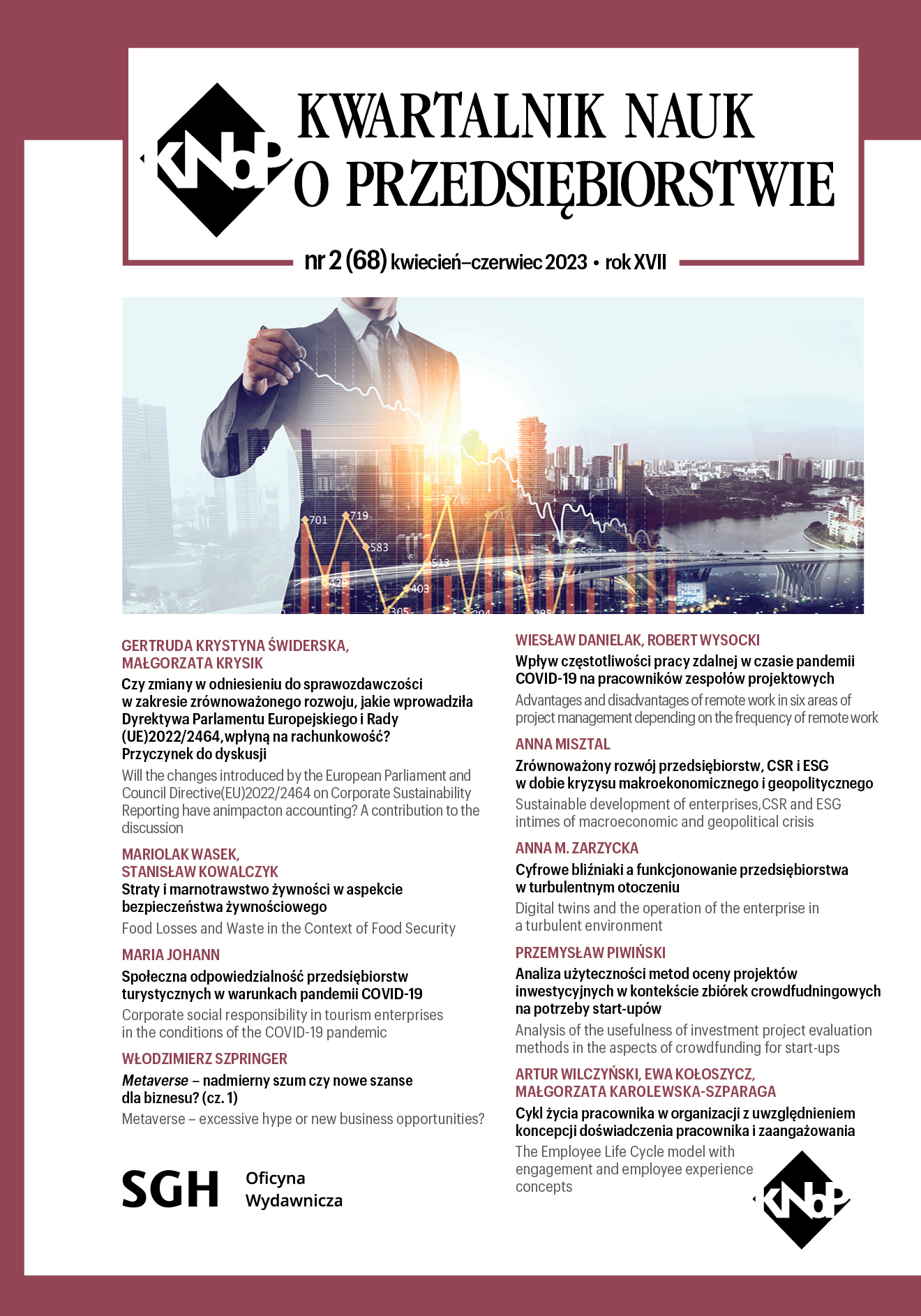Digital twins and the operation of the enterprise in a turbulent environment
Main Article Content
Abstract
Digital twins (DT) are currently an important technological trend, but still insufficiently recognized in the literature on the subject. The aim of this article is to identify this phenomenon, the areas of its application and the impact on the operation of the company in a turbulent environment. This goal was achieved through the analysis of literature, databases and electronic resources as well as a case study. The technology of digital twins, which is the digital equivalent of things, objects and processes from the real world, is used mainly in the production process, but also in the areas of product design and testing, distribution and customer service. The considerations confirm the thesis about the positive impact of DT on the functioning of the company in a rapidly changing environment by increasing strategic flexibility.
Downloads
Article Details

This work is licensed under a Creative Commons Attribution 4.0 International License.
The author of the article declares that the submitted article does not infringe the copyrights of third parties. The author agrees to subject the article to the review procedure and to make editorial changes. The author transfers, free of charge, to SGH Publishing House the author's economic rights to the work in the fields of exploitation listed in the Article 50 of the Act of 4 February 1994 on Copyright and Related Rights – provided that the work has been accepted for publication and published.
SGH Publishing House holds economic copyrights to all content of the journal. Placing the text of the article in a repository, on the author's home page or on any other page is allowed as long as it does not involve obtaining economic benefits, and the text will be provided with source information (including the title, year, number and internet address of the journal).
References
CIECH SA, https://ciechgroup.com/grupa-ciech/spolki-grupy-ciech/ciech-soda-polska/ (dostęp: 3.02.2023).
Cyfrowy bliźniak, Kaizen&Lean (2022), https://logistyczny.com/biblioteka/kaizen-lean/item/6779‑cyfrowy-blizniak (dostęp: 8.02.2023).
Dachser (2022), https://www.dachser.pl/pl/mediaroom/Cyfrowy-bliniak-Dachser-i-Instytut-Fraunhofer-IML-zwikszaj-przejrzysto-obsugi-adunkow-zbiorowych-19433?search=&bookmarked=false (dostęp: 9.02.2023).
Digital Innovation Hub (2021), https://www.dih4.ai/pl/news/39/do-czego-firmy-wykorzystujacyfrowe-blizniaki (dostęp: 8.02.2023).
Gelernter D. (2020), Mirror Worlds: Or: The Day Software Puts the Universe in a Shoebox…How It Will Happen and What It Will Mean (on-line edn, Oxford Academic, 12 Nov. 2020), https://doi.org/10.1093/oso/9780195068122.003.0008 (dostęp: 19.11.2022).
Glaessgen, E. H., Stargel, D. S. (2012), The Digital Twin Paradigm for Future NASA and U. S. Air Force Vehicles. In 53 rd Struct. Dyn. Mater. Conf. Special Session: Digital Twin, Honolulu, HI, US.
Haag S., Anderl R. (2018), Digital twin – Proof of concept, “Manufacturing Letters”, Volume 15, Part B, 2018, s. 64–66.
Helbing D., Argota Sanchez-Vaquerizo, J. (2022), Digital Twins: Potentials, Ethical Issues, and Limitations (July 19, 2022). Handbook on the Politics and Governance of Big Data and Artificial Intelligence, Edward Elgar, Forthcoming, Available at SSRN: https://ssrn.com/abstract=4167963 or http://dx.doi.org/10.2139/ssrn.4167963. https://www.ibm.com/topics/what-is-a-digital-twin?mhsrc=ibmsearch_a&mhq=digital%20twin (dostęp: 18.11.2022).
Już dziś w przemyśle mamy cyfrową rzeczywistość, „Rzeczpospolita”, 30.12.2022.
Kritzinger W., Karner M., Traar G., Hejnes J., Sihn W. (2018), Digital Twin in manufacturing: A categorical literature review and classification, IFAC PapersOnLine Elsevier.
Kuhn T. (2017), Digitaler Zwilling, “Informatik Spektrum”, 40 (5), s. 440–444.
Lis P., Po co mi rozszerzona rzeczywistość?, 2020, https://przemyslprzyszlosci.gov.pl/po-co-mi-rozszerzona-rzeczywistosc/ (dostęp: 19.11.2022).
Maciążek M. (2021), Cyfrowe bliźniaki/digital twins i ich wpływ na rewolucję w produkcji 3D, https://3d.edu.pl/cyfrowe-blizniaki-digital-twins-i-ich-wplyw-na-rewolucje-w-produkcji-3d/ (dostęp: 27.11.2022).
Mazurek J. (2019), Cyfrowe bliźniaki, https://www.computerworld.pl/news/Cyfrowe-blizniaki, 414217.html (dostęp: 12.11.2022).
Negri, E., Fumagalli, L., Macchi, M. (2017), A Review of the Roles of Digital Twin in CPS-based Production Systems, “Procedia Manufacturing”, 11, s. 939–948.
Ricci A., Tummolini L., Castelfranchi C., Piunti M. (2015), The Mirror World: Preparing for Mixed- Reality Living, Pervasive Computing, IEEEE, 2015, June, s. 60–63.
Siemens AG, https://new.siemens.com/pl/pl/o-firmie/o-nas.html (dostęp: 30.01.2023).
Siemens tworzy symulator linii do produkcji sody dla Grupy CIECH, https://www.chemiaibiznes.com.pl/artykuly/siemens-tworzy-symulator-linii-do-produkcji-sody-dla-grupy-ciech (dostęp: 7.02.2023).
Tech Vision 2021: Ważne trendy technologiczne, https://www.accenture.com/pl-pl/insights/technology/technology-trends-2021 (dostęp: 12.11.2022).

